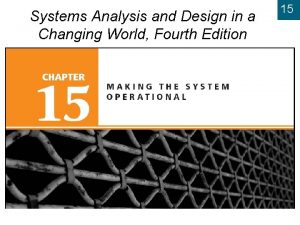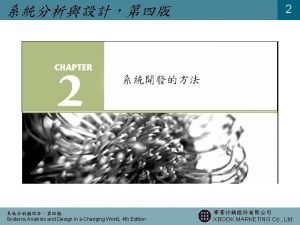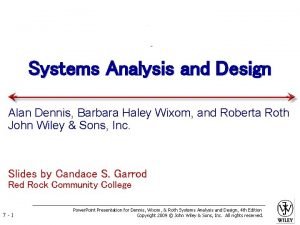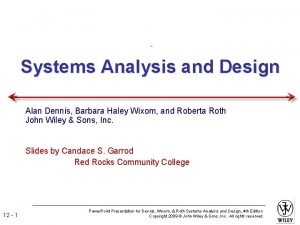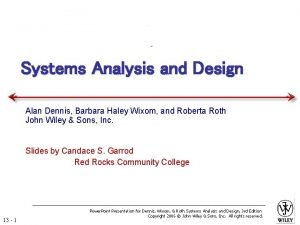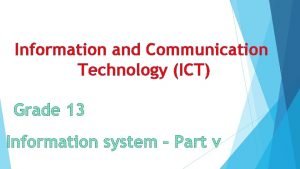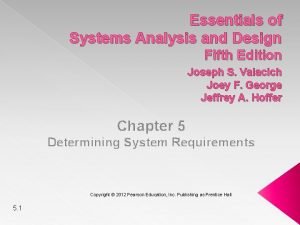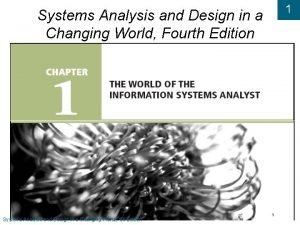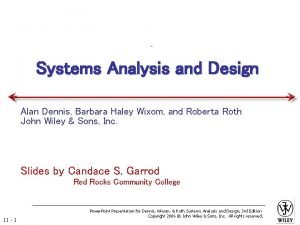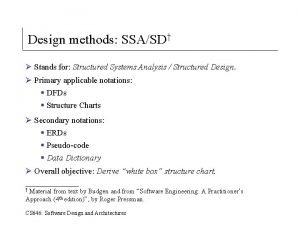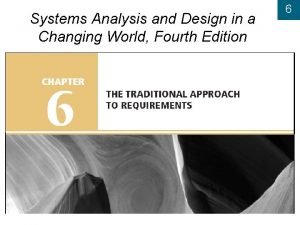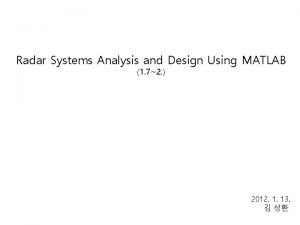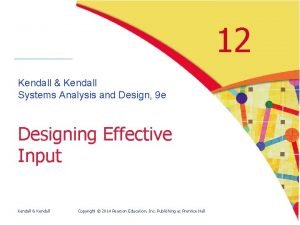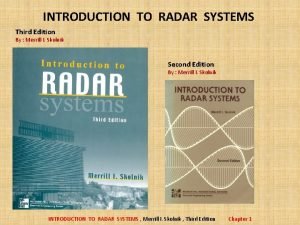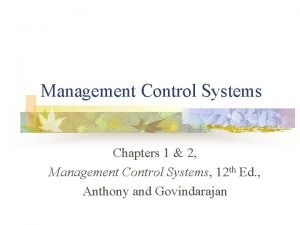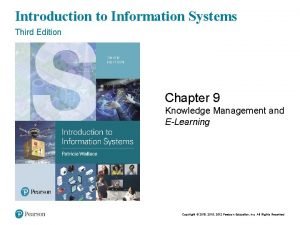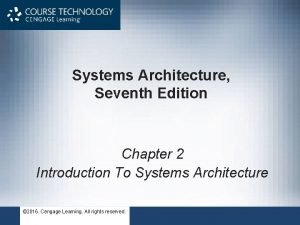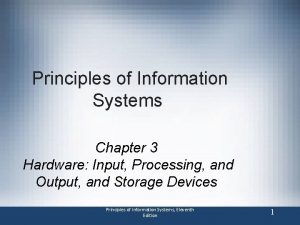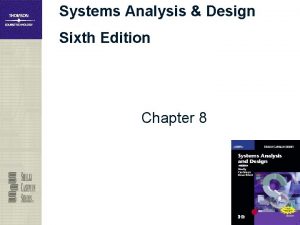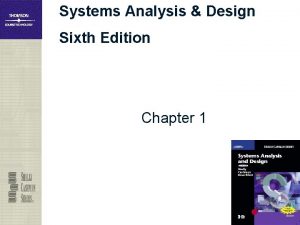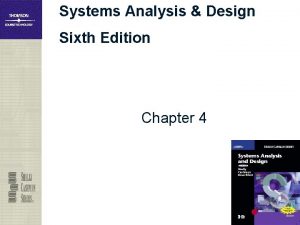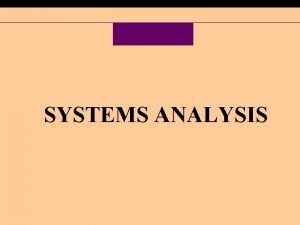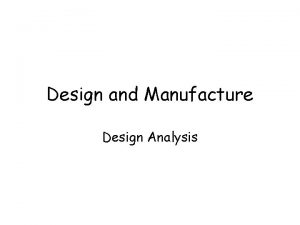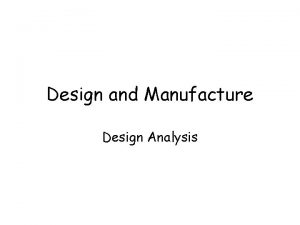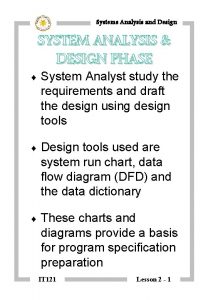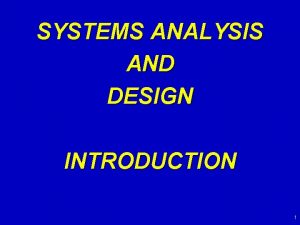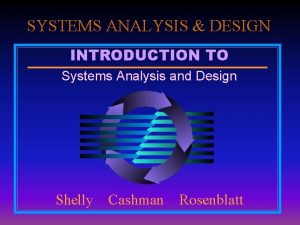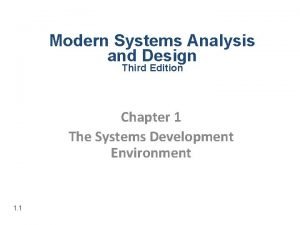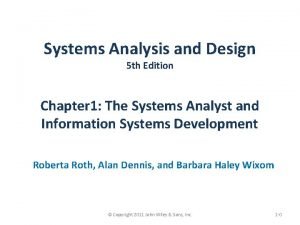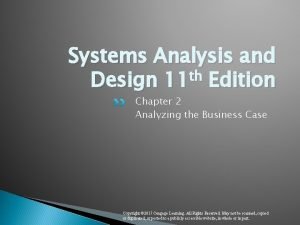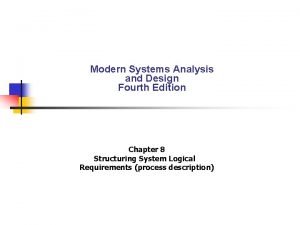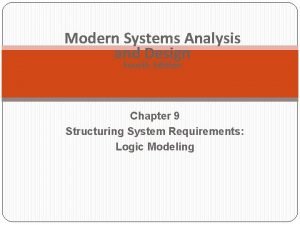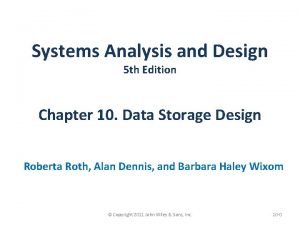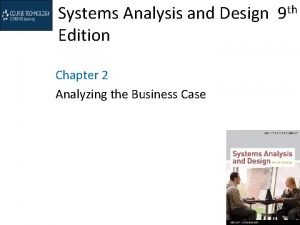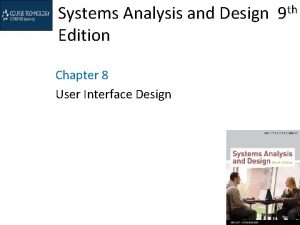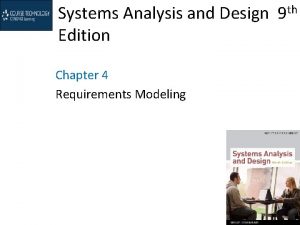Systems Analysis and Design 5 th Edition Chapter






























































- Slides: 62

Systems Analysis and Design 5 th Edition Chapter 7. The Design Phase, Design Strategy, and Architecture Design Roberta Roth, Alan Dennis, and Barbara Haley Wixom © Copyright 2011 John Wiley & Sons, Inc. 7 -0

Chapter 7 Outline § Transition from requirements to design. § System acquisition strategies. - Custom development. - Packaged software. - Outsourcing. §Influences on the acquisition strategies. §Selecting an acquisition strategy. © Copyright 2011 John Wiley & Sons, Inc. 7 -1

Chapter 7 Outline, con’t. §Elements of an architecture design. §Creating an architecture design. §Hardware and software specification. © Copyright 2011 John Wiley & Sons, Inc. 8 -2

INTRODUCTION § The design phase decides how the new system will operate. § The design phase develops the system requirements that describe details for building the system. § We also describe three alternative strategies for acquiring the system. © Copyright 2011 John Wiley & Sons, Inc. 7 -3

INTRODUCTION, con’t. § Architecture design § § – Plans for how the system will be distributed across multiple computers and what hardware, operating system software, and application software will be used for each computer. Key factors in architecture design – Nonfunctional requirements developed early in the analysis phase play a key role in architecture design. Hardware and software specification – Defines what hardware and software needed for the new system. © Copyright 2011 John Wiley & Sons, Inc. 8 -4

TRANSITION FROM REQUIREMENT TO DESIGN § The purpose of the analysis phase is to figure out what the business needs. The purpose of the design phase is to decide how to build it. § During the initial part of design, the business requirements are converted into system requirements that describe the technical details for building the system. § System requirements are communicated through a collection of design documents and physical process and data models. © Copyright 2011 John Wiley & Sons, Inc. 7 -5

(cont’d) § Activities of the design phase © Copyright 2011 John Wiley & Sons, Inc. 7 -6

(cont’d) § At the end of the design phase, the final deliverable called system specification is created. § System specification outline © Copyright 2011 John Wiley & Sons, Inc. 7 -7

SYSTEM ACQUISITION STRATEGIES §There are three primary ways to approach the creation of a new system: 1. Develop a custom application in-house. 2. Buy a packaged system and (possibly) customize it; and 3. Rely on an external vendor, developer, or service provider to build or provide the system. © Copyright 2011 John Wiley & Sons, Inc. 7 -8

Custom Development § Custom development – building a new system from scratch. § Pros of custom development: - It allows developers to be flexible and creative in the way they solve business problems. - It allows to take advantage of current technologies that can support strategic efforts. - It builds technical skills and functional knowledge within the organization. © Copyright 2011 John Wiley & Sons, Inc. 7 -9

(cont’d) § Cons of custom development: - It requires a dedicated effort that include long hours and hard work. - It requires a variety of skills, but high skilled IS professionals are difficult to hire and retain. - The risks associated with building a system from the ground up can be quite high. © Copyright 2011 John Wiley & Sons, Inc. 7 -10

Packaged Software § Many organizations buy packaged software that has been written for common business needs. § It can be much more efficient to buy programs that have already been created and tested, and a packaged system can be bought and installed quickly compared with a custom system. § Packaged software can range from small singlefunction tools to huge all-encompassing system such as ERP (enterprise resource planning) applications. © Copyright 2011 John Wiley & Sons, Inc. 7 -11

(cont’d) § One problem of packaged software is that companies utilizing packaged software must accept the functionality that is provided by the system. § Most packaged applications allow for customization or the manipulation of system parameters to change the way certain features work. § A custom-built add-on program that interfaces with the packaged application, called a workaround, can be created to handle special needs. © Copyright 2011 John Wiley & Sons, Inc. 7 -12

(cont’d) § Systems Integration refers to the process of building new systems by combining packaged software, existing legacy systems, and new software written to integrate them. § The key challenge in systems integration is finding ways to integrate the data produced by the different packages and legacy systems. © Copyright 2011 John Wiley & Sons, Inc. 7 -13

Outsourcing § Outsourcing means hiring an external vendor, developer, or service provider to create or supply the system. § Outsourcing firms called application service providers (ASPs) supply software applications and/or services over the Internet. § Software as a service (Saa. S) is an extension of the ASP model. § Outsourcing has many advantages such as a low cost of entry and a short setup time. © Copyright 2011 John Wiley & Sons, Inc. 7 -14

(cont’d) § Risks of outsourcing: – Compromising confidential information – Losing control over future development – Losing important skills of in-house professionals. § You should never outsource what you do not understand. § Carefully choose an outsourcing firm with a proven track record. © Copyright 2011 John Wiley & Sons, Inc. 7 -15

(cont’d) § Three types of outsourcing contracts: - Time and arrangements: pay for whatever time and expenses are needed to get the job done. - Fixed-price contract - Value-added contract: the outsourcer reaps some percentage of the completed system’s benefits. © Copyright 2011 John Wiley & Sons, Inc. 7 -16

(cont’d) Outsourcing Guidelines © Copyright 2011 John Wiley & Sons, Inc. 7 -17

INFLUENCES ON THE ACQUISTION STRATEGY Project characteristics that influence the choice of acquisition strategy © Copyright 2011 John Wiley & Sons, Inc. 7 -18

Business Need § If the business need for the system is common and the technical solutions already exist, packaged software is a solution. § A custom solution should be explored when the business need is unique. § Outsourcing is used in situations where the business need is not a critical element of company strategy. © Copyright 2011 John Wiley & Sons, Inc. 7 -19

In-House Experience §If in-house experience exists for all the functional and technical needs of the system, it will be easier to build a custom application. §A packaged system may be a better alternative for companies that do not have the technical skills to build the desired system. © Copyright 2011 John Wiley & Sons, Inc. 7 -20

Project Skills §The skills that are applied during projects are either technical (e. g. , SQL) or functional (e. g. , e-commerce). §Different design alternatives are more viable, depending on how important the skills are to the company’s strategy. © Copyright 2011 John Wiley & Sons, Inc. 7 -21

Project Management §Custom applications require excellent project management and a proven methodology. §There are so many things that can push a project off track, such as funding obstacles, staffing, and overly demanding business users. © Copyright 2011 John Wiley & Sons, Inc. 7 -22

(cont’d) § The project team should choose to develop a custom application only if it is certain that the underlying coordination and control mechanisms will be in place. § Packaged and outsourcing alternatives also must be managed; however, they are more shielded from internal obstacles. © Copyright 2011 John Wiley & Sons, Inc. 7 -23

Time Frame § When time is a factor, the project team should probably start looking for a system that is already built and tested. § If a custom alternative is chosen, and the time frame is very short, consider using techniques like timeboxing to manage the problem. § An outsourcing solution could take as long a custom development initiative. © Copyright 2011 John Wiley & Sons, Inc. 7 -24

SELECTING AN ACQUISITION STRATEGY § To implement the strategies, additional information is needed. - What tools and technologies are needed for a custom development project? - What vendors make products that address the project needs? - What service providers would be able to build this application if outsourced? § One helpful tool is the request for proposal (RFP), a document that solicits a formal proposal from a potential vendor, developer, or service provider. © Copyright 2011 John Wiley & Sons, Inc. 7 -25

(cont’d) § RFPs describe in detail the system or service that is needed, and vendor respond by describing in detail how they could supply those needs. § For smaller projects with smaller budgets, a request for information (RFI) may be sufficient, as it is shorter and less detailed. § When a list of equipment is so complete that the vendor needs only provide a price, a request for quote (RFQ) may be used. © Copyright 2011 John Wiley & Sons, Inc. 7 -26

Developing an Alternative Matrix § The alternative matrix combines several feasibility analyses into one matrix. § It contains technical, economical and organizational feasibilities for each system candidate, pros and cons, and other information. § The matrix is a grid with alternatives across the top and different criteria along the side. © Copyright 2011 John Wiley & Sons, Inc. 7 -27

(cont’d) §Sometimes, weights and scores are added to create a weighted alternative matrix. §The score assigned is a subjective assignment. §To avoid a biased analysis, each analyst develops ratings independently. © Copyright 2011 John Wiley & Sons, Inc. 7 -28

(cont’d) Sample Alternative Matrix Using Weights © Copyright 2011 John Wiley & Sons, Inc. 7 -29

ELEMENTS OF AN ARCHITECTURE DESIGN § The objective of architecture design is to determine how the software components of the information system will be assigned to the hardware devices of the system. © Copyright 2011 John Wiley & Sons, Inc. 7 -30

Architectural Components § The major architectural components of any system are the software and the hardware. § All software systems can be divided into four basic functions: - Data storage. - Data access logic: the processing required to access stored data. - Application logic: the logic documented in the DFDs, use cases, and functional requirements. - Presentation logic: the display of information to the user and the acceptance of the user’s commands. © Copyright 2011 John Wiley & Sons, Inc. 7 -31

(cont’d) §The three primary hardware components: - Client computers: Input-output devices employed by users (e. g. , PCs, laptops, handheld devices, smart phones) - Servers: Larger multi-user computers used to store software and data. - The network: Connects the computers. © Copyright 2011 John Wiley & Sons, Inc. 7 -32

Client-Server Architectures § Client-server architectures balance the processing between client devices and one or more server devices. § The client is responsible for the presentation logic, whereas the server is responsible for the data access logic and data storage. § A thick or fat client contains all or most of application logic; whereas a thin client contains a small portion of the application logic. © Copyright 2011 John Wiley & Sons, Inc. 7 -33

(cont’d) © Copyright 2011 John Wiley & Sons, Inc. 7 -34

(cont’d) § Client-server architectures have four important benefits. - Scalable - Can support different types of clients and servers through middleware. - The presentation logic, the application logic, and the data processing logic can be independent. - If a server fails, only the applications requiring that sever are affected. § The major limitation of client-server architectures is their complexity. © Copyright 2011 John Wiley & Sons, Inc. 7 -35

Client-Server Tiers § There are many ways in which the application logic can be partitioned between the client and the server. §The arrangement in Figure 7 -7 is called two-tiered architecture. © Copyright 2011 John Wiley & Sons, Inc. 7 -36

(cont’d) §Three-tiered architecture © Copyright 2011 John Wiley & Sons, Inc. 7 -37

(cont’d) §n-tiered architecture © Copyright 2011 John Wiley & Sons, Inc. 7 -38

Less Common Architectures Server-Based Architectures © Copyright 2011 John Wiley & Sons, Inc. 7 -39

Client-Based Architectures © Copyright 2011 John Wiley & Sons, Inc. 7 -40

Advances in Architecture Configurations §Advances in hardware, software, and networking have given rise to a number of new architecture options. - Virtualization. - Cloud computing. © Copyright 2011 John Wiley & Sons, Inc. 7 -41

Virtualization § Virtualization refers to a creation of a virtual device or resource, such as a server or storage device. § Server virtualization involves partitioning a physical server into smaller virtual servers. § Storage virtualization involves combining multiple network storage devices into what appears to be single storage unit. © Copyright 2011 John Wiley & Sons, Inc. 7 -42

Cloud Computing § Cloud computing – everything from computing power to computing infrastructure, applications, business processes to personal collaboration can be delivered as a service wherever and whenever needed. § The “cloud” can be defined as the set of hardware, networks, storages, devices, and interfaces that combine to deliver aspects of computing as a service. © Copyright 2011 John Wiley & Sons, Inc. 7 -43

(cont’d) § Cloud computing can be implemented in three ways: - private cloud, - public cloud, and - hybrid cloud. § At this time, cloud computing is in its early stage of development. © Copyright 2011 John Wiley & Sons, Inc. 7 -44

(cont’d) § Advantages of cloud computing 1. The resources allocated can be increased or deceased based on demand. 2. Cloud customers can obtain cloud resources in a straightforward fashion. 3. Cloud services typically have standardized APIs (application program interfaces). 4. The cloud computing model enables customers to be billed for resources as they are used. © Copyright 2011 John Wiley & Sons, Inc. 7 -45

Comparing Architecture Options § Most systems are built to use the existing infrastructure in the organization, so often the current infrastructure restricts the choice of architecture. § Each of the architectures discussed has its strengths and weaknesses. § Client-server architectures are strongly favored on the basis of the cost of infrastructure. © Copyright 2011 John Wiley & Sons, Inc. 7 -46

CREATING AN ARCHITECTURE DESIGN § Creating an architecture design begins with the nonfunctional requirements. § Refine the nonfunctional requirements into more detailed requirements for the selection of architecture. § The nonfunctional requirements and the architecture design are used to develop the hardware and software specification. © Copyright 2011 John Wiley & Sons, Inc. 7 -47

Operational Requirements © Copyright 2011 John Wiley & Sons, Inc. 7 -48

Performance Requirements © Copyright 2011 John Wiley & Sons, Inc. 7 -49

Security Requirements © Copyright 2011 John Wiley & Sons, Inc. 7 -50

Cultural and Political Requirements © Copyright 2011 John Wiley & Sons, Inc. 7 -51

Designing the Architecture § In many cases, the technical environment requirements as driven by the business requirements define the application architecture. § If the technical environment requirements do not require the choice of a specific architecture, then other nonfunctional requirements become important for designing the architecture. © Copyright 2011 John Wiley & Sons, Inc. 7 -52

(cont’d) §Nonfunctional Requirements and Their Implications for Architecture Design © Copyright 2011 John Wiley & Sons, Inc. 7 -53

HARDWARE AND SOFTWARE SPECIFICATION §The design phase is also the time to begin selecting and acquiring the hardware and software that will be needed for the future system. §The hardware and software specification is a document that describes what hardware and software needed to support the application. © Copyright 2011 John Wiley & Sons, Inc. 7 -54

(cont’d) § Sample hardware and software specification © Copyright 2011 John Wiley & Sons, Inc. 7 -55

(cont’d) § First, you define software – Define the operating system and any special purpose software – Consider additional costs such as training, warranty, maintenance, licensing agreements. § Next, you create a list of the hardware needed – Database servers, network servers, peripheral devices, clients, backup devices, storage components, and others. § Finally, you describe the minimum requirements for each piece of hardware. © Copyright 2011 John Wiley & Sons, Inc. 7 -56

(cont’d) § Factors in hardware and software selection © Copyright 2011 John Wiley & Sons, Inc. 7 -57

SUMMARY § Transitioning from requirements to design - The design phase develops the blueprint for the new system. - The main deliverable from the design phase is the system specification. § System acquisition strategies - Custom application in-house. - Packaged system. - Outsourcing. © Copyright 2011 John Wiley & Sons, Inc. 7 -58

(cont’d) § Influences on acquisition strategy - Each acquisition strategy has its strengths and weaknesses. - Consider such issues as the uniqueness of business need, in-house experiences, and the importance of project skills. § Selecting a acquisition strategy - An alternative matrix can help the design team make the decision regarding the specific acquisition strategy. - The request for proposal and request for quote are ways to gather accurate details regarding the alternatives. © Copyright 2011 John Wiley & Sons, Inc. 7 -59

(con’t) §Application architecture. - Client-server architecture. - Advances in architecture configurations: virtualization and cloud computing. §Architecture Design. - Nonfunctional requirements. §Hardware and software specification. - A document that describes what hardware and software needed to support the application. © Copyright 2011 John Wiley & Sons, Inc. 7 -60

Copyright 2011 John Wiley & Sons, Inc. All rights reserved. Reproduction or translation of this work beyond that permitted in Section 117 of the 1976 United States Copyright Act without the express written permission of the copyright owner is unlawful. Request for further information should be addressed to the Permissions Department, John Wiley & Sons, Inc. The purchaser may make back-up copies for his/her own use only and not for redistribution or resale. The Publisher assumes no responsibility for errors, omissions, or damages, caused by the use of these programs or from the use of the information contained herein. © Copyright 2011 John Wiley & Sons, Inc. 7 -61
 Modern system analysis and design
Modern system analysis and design Modern systems analysis and design 7th edition
Modern systems analysis and design 7th edition Kendall & kendall systems analysis and design
Kendall & kendall systems analysis and design Using mis (10th edition) 10th edition
Using mis (10th edition) 10th edition Using mis 10th edition
Using mis 10th edition Systems analysis and design in an age of options
Systems analysis and design in an age of options Gantt chart system analysis and design
Gantt chart system analysis and design Systems analysis and design in a changing world
Systems analysis and design in a changing world System analysis and design in a changing world
System analysis and design in a changing world Systems analysis and design dennis
Systems analysis and design dennis Introduction to systems analysis and design
Introduction to systems analysis and design What is ssadm
What is ssadm Modern systems analysis and design
Modern systems analysis and design Kendall and kendall system analysis and design
Kendall and kendall system analysis and design Alan dennis system analysis design
Alan dennis system analysis design Systems analysis and design alan dennis
Systems analysis and design alan dennis Systems analysis and design alan dennis
Systems analysis and design alan dennis Systems analysis and design alan dennis
Systems analysis and design alan dennis Systems analysis and design alan dennis
Systems analysis and design alan dennis Systems analysis and design alan dennis
Systems analysis and design alan dennis Systems analysis and design alan dennis
Systems analysis and design alan dennis Ssadm
Ssadm Radar range equation snr
Radar range equation snr Object-oriented systems analysis and design using uml
Object-oriented systems analysis and design using uml A modern approach to systems analysis and design
A modern approach to systems analysis and design Kendall and kendall system analysis and design
Kendall and kendall system analysis and design System analysis and design in a changing world
System analysis and design in a changing world Systems analysis and design in a changing world
Systems analysis and design in a changing world Systems analysis and design in a changing world
Systems analysis and design in a changing world Systems analysis and design alan dennis
Systems analysis and design alan dennis Systems analysis and design alan dennis
Systems analysis and design alan dennis Systems analysis and design alan dennis
Systems analysis and design alan dennis Ssadm
Ssadm Essentials of systems analysis and design
Essentials of systems analysis and design Systems analysis and design in a changing world
Systems analysis and design in a changing world Systems analysis and design alan dennis
Systems analysis and design alan dennis List the five basic steps of ssa/sd process
List the five basic steps of ssa/sd process System analysis and design in a changing world
System analysis and design in a changing world Systems analysis and design in a changing world
Systems analysis and design in a changing world Radar systems analysis and design using matlab
Radar systems analysis and design using matlab Kendall and kendall system analysis and design
Kendall and kendall system analysis and design Output design in system analysis
Output design in system analysis Expert systems: principles and programming, fourth edition
Expert systems: principles and programming, fourth edition User interface design in system analysis and design
User interface design in system analysis and design Dialogue design in system analysis and design
Dialogue design in system analysis and design Define structured analysis.
Define structured analysis. Fact finding methods in system analysis and design
Fact finding methods in system analysis and design Organizational feasibility in system analysis and design
Organizational feasibility in system analysis and design Principles of electronic communication systems 3rd edition
Principles of electronic communication systems 3rd edition Introduction to radar systems 3rd edition pdf
Introduction to radar systems 3rd edition pdf Introduction to information systems 6th edition
Introduction to information systems 6th edition Fundamentals of information systems 9th edition
Fundamentals of information systems 9th edition Fundamentals of information systems 9th edition
Fundamentals of information systems 9th edition Principles of information systems
Principles of information systems Management information systems 16th edition
Management information systems 16th edition Management control systems 12th edition
Management control systems 12th edition Introduction to information systems 3rd edition
Introduction to information systems 3rd edition Introduction to information systems 5th edition
Introduction to information systems 5th edition Systems architecture 7th edition pdf
Systems architecture 7th edition pdf Principles of information systems
Principles of information systems Principles of information systems 11th edition
Principles of information systems 11th edition Modern operating systems 3rd edition
Modern operating systems 3rd edition Tanenbaum structured computer organization
Tanenbaum structured computer organization


























